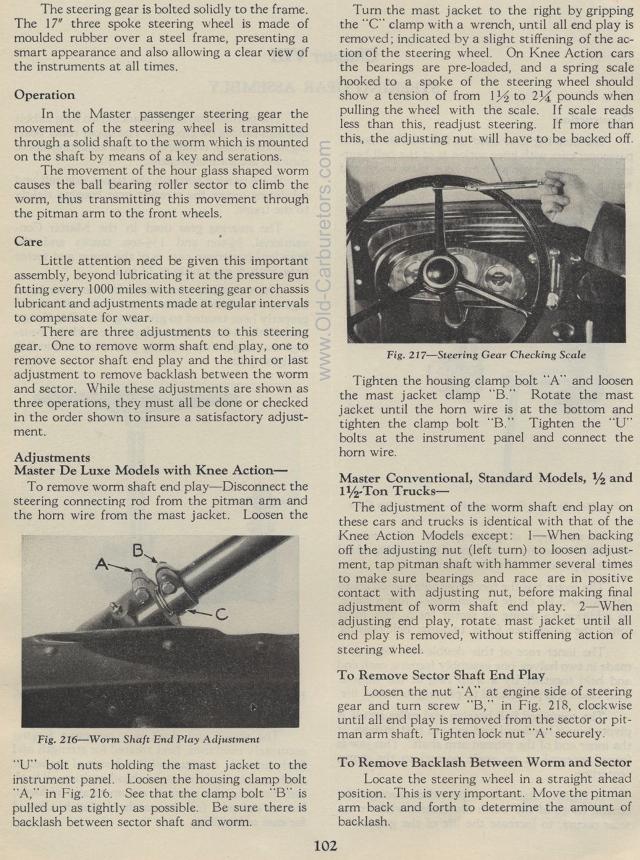Skip to: site menu | section menu | main content
The steering gear is bolted solidly to the frame. The 17" three spoke steering wheel is made of moulded rubber over a steel frame, presenting a smart appearance and also allowing a clear view of the instruments at all times.
The steering gear is bolted solidly to the frame. The 17" three spoke steering wheel is made of moulded rubber over a steel frame, presenting a smart appearance and also allowing a clear view of the instruments at all times.
Operation
In the Master passenger steering gear the movement of the steering
wheel is transmitted through a solid shaft to the worm which
is mounted on the shaft by means of a key and serations.
The movement of the hour glass shaped worm causes the ball bearing
roller sector to climb the worm, thus transmitting this movement
through the pitman arm to the front wheels.
Care
Little attention need be given this important assembly, beyond
lubricating it at the pressure gun fitting every 1000 miles with
steering gear or chassis lubricant and adjustments made at regular
intervals to compensate for wear.
There are three adjustments to this steering gear. One to remove
worm shaft end play, one to remove sector shaft end play and the
third or last adjustment to remove backlash between the worm and
sector. While these adjustments are shown as three operations,
they must all be done or checked in the order shown to insure a
satisfactory adjustment.
Adjustments
Master De Luxe Models with Knee Action
To remove worm shaft end play—Disconnect the steering connecting
rod from the pitman arm and the horn wire from the mast jacket.
Loosen the
Fig. 216—Worm Shaft End Play Adjustment
"U" bolt nuts holding the mast jacket to the instrument
panel. Loosen the housing clamp bolt "A," in Fig. 216.
See that the clamp bolt "B" is pulled up as tightly as
possible. Be sure there is backlash between sector shaft and worm.
Turn the mast jacket to the right by gripping the "C" clamp
with a wrench, until all end play is removed; indicated by a slight
stiffening of the action of the steering wheel. On Knee Action
cars the bearings are pre-loaded, and a spring scale hooked to
a spoke of the steering wheel should show a tension of from 1 %
to 2% pounds when pulling the wheel with the scale. If scale reads
less than this, readjust steering. If more than this, the adjusting
nut will have to be backed off.
Fig. 217—Steering Gear Checking Scale
Tighten the housing clamp bolt "A" and loosen the mast
jacket clamp "B." Rotate the mast jacket until the horn
wire is at the bottom and tighten the clamp bolt "B." Tighten
the "U" bolts at the instrument panel and connect the
horn wire.
Master Conventional, Standard Models, 1/2 and 11/2-Ton Trucks
The adjustment of the worm shaft end play on these cars and trucks
is identical with that of the Knee Action Models except: 1—When
backing off the adjusting nut (left turn) to loosen adjustment,
tap pitman shaft with hammer several times to make sure bearings
and race are in positive contact with adjusting nut, before making
final adjustment of worm shaft end play. 2—When adjusting
end play, rotate mast jacket until all end play is removed, without
stiffening action of steering wheel.
To Remove Sector Shaft End Play
Loosen the nut "A" at engine side of steering gear and
turn screw "B," in Fig. 218, clockwise until all end
play is removed from the sector or pit-man arm shaft. Tighten lock
nut "A" securely.
To Remove Backlash Between Worm and Sector
Locate the steering wheel in a straight ahead position. This is
very important. Move the pitman arm back and forth to determine
the amount of backlash.
